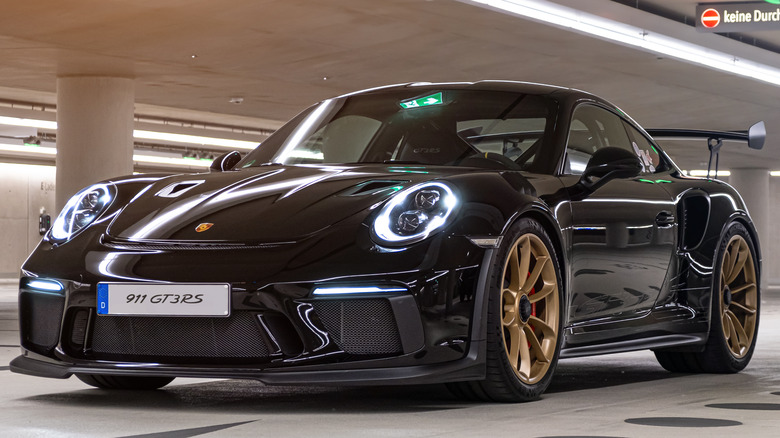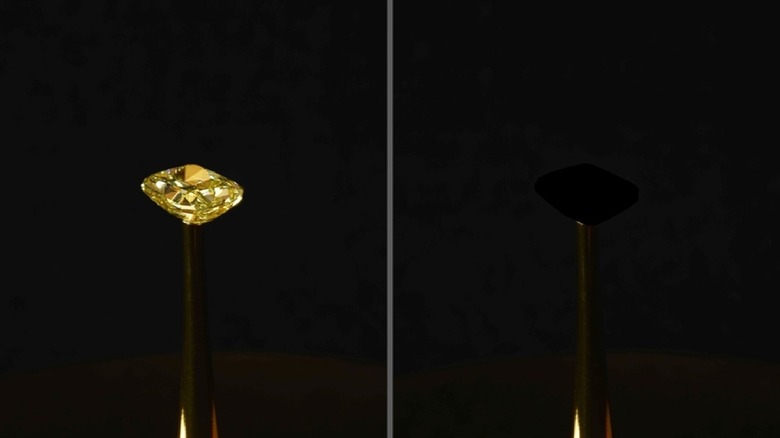World's Blackest Paint Meets A Porsche 911 And The Results Are Wild
Although Porsche 911s are quite expensive, they aren't all that uncommon. According to the New York Times, more than a million units have been made since the sports coupe first rolled off a German production line in 1964. Amongst the million Porsche vehicles are a fair number of black cars — black, along with red and white, is among the more common colors Porsche buyers tend to go for, according to the automaker. But the Porsche 911 is a competitive car for competitive people, so how do you make a common sports car in a common color really stand out? A Japan-based company recently decided its black Porsche 911 Turbo was not black enough, and so the company had its Porsche resprayed in the blackest black currently available for purchase.
The entire 911 has received a coating of Black Musou, which its manufacturer — South Korea-based Ko-Pro — claims is the blackest water-based acrylic paint on the market. The paint is designed to absorb 99.4% of all light hitting it. According to Boston University's Alumni Magazine, a typical matte black paint will only absorb 80% of the light that hits it. The magazine also reports a previous contender for the title of blackest black. Singularity black was developed for NASA to reduce the glare on telescopes that are used to observe distant stars. In the year 2022, a Japanese company car has a more advanced coating than the high-level equipment used by the world's most accomplished space agency. That's where we are.
The Musou-painted 911 isn't just the blackest Porsche ever, it has also managed to snatch the title of blackest car ever from the Vantablack BMW X6 that was put on display at the 2019 Frankfurt Motor Show.
It's like staring into a six-cylinder void
After a lot of masking, the car — which is owned by Far East Co. Ltd – was ready for its void-like respray. The effect was pretty staggering from the get-go. The very black paint instantly dulled the car's regular gloss finish and initially looked almost grey under the harsh light. It turns out you need more than one layer of the world's blackest paint to get a sports car truly black, so layer after layer of the light-absorbing material was added. The men doing the paint job periodically checked in with a handheld light. In total, seven layers of paint were applied to the car. The wet paint still had a small amount of gloss, but once it dried the deep matte effect was clearly apparent. The car also took on an almost velvet-like texture.
The respray was both a shocking display of scientific advancement and also a touch confusing. Logically, you buy a Porsche because you want to show off a bit, so why you would make it look like something you still haven't unlocked in a racing game is beyond us. Sadly, the owner has confirmed that the paint job is only temporary. Car paint jobs usually consist of a tougher paint coated in a protective clear coat finish and water-based acrylics aren't anywhere durable enough to coat a car with. It will no longer be the blackest Porsche 911 in the universe following an appointment with a pressure washer that has been scheduled for the end of July 2022.
Why are we searching for the perfect black
You may wonder why so much effort is going into developing a perfectly black paint. The answer mainly focuses on the scientific and artistic benefits that would come from having a true black. MIT professor Brian Wardle explains: "There are optical and space science applications for very black materials, and of course, artists have been interested in black, going back well before the Renaissance."
To develop a true black, scientists would need a material that absorbs all light. We see objects and colors because light reflects off their surfaces and into our eyes. This task has yet to be accomplished, but MIT did develop a substance that captures "at least 99.995%" of the light that touches it.
The substance is made from carbon nanotubes grown "on a surface of chlorine-etched aluminum foil." Wardle describes the material as "ten times blacker than anything that's ever been reported" but claims blacker blacks will be developed. "Someone will find a blacker material, and eventually, we'll understand all the underlying mechanisms and will be able to properly engineer the ultimate black," he said.
So what are the applications? Artists are always on the lookout for more vibrant colors and shades. The still imperfect carbon nanotube black creates a void-like appearance that makes objects look like they've been removed from reality. As far as scientific applications go, there are many experiments that involve accurately measuring light. Being able to take reflections and stray beams of light out of the equation will make those measurements more accurate. As mentioned, NASA already used a kind of black paint to coat the inside of their telescopes — it just isn't as advanced as the black paint Japanese businessmen use to coat their Porsches.

